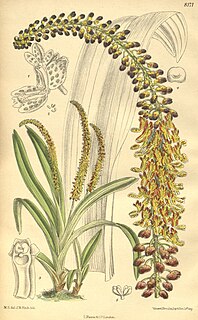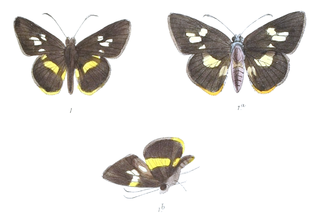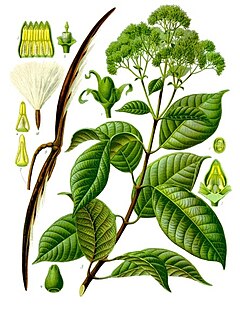
Canarium is a genus of about 100 species of tropical and subtropical trees, in the family Burseraceae. They grow naturally across tropical Africa, south and southeast Asia, Indochina, Malesia, Australia and western Pacific Islands; including from southern Nigeria east to Madagascar, Mauritius, Sri Lanka and India; from Burma, Malaysia and Thailand through the Malay Peninsula and Vietnam to south China, Taiwan and the Philippines; through Borneo, Indonesia, Timor and New Guinea, through to the Solomon Islands, New Caledonia, Fiji, Samoa, Tonga and Palau.
Trigonostemon is a plant genus of the family Euphorbiaceae and the sole member of its tribe (Trigonostemoneae). It was first described as a genus in 1826. It is native to Southeast Asia, southern China, the Indian Subcontinent, Queensland, and a few islands in the western Pacific.

Cleistanthus is a plant genus of the family Phyllanthaceae, tribe Bridelieae, first described as a genus in 1848. It is widespread in much of the Old World Tropics in Asia, Africa, Australia, and various oceanic islands. Cleistanthus collinus is known for being toxic and may be the agent of homicides or suicides.

Daemonorops is a genus of rattan palms in the family Arecaceae found primarily in the tropics and subtropics of southeastern Asia with a few species extending into southern China and the Himalayas.

Zela is an Indomalayan genus of grass skippers.

Anodendron is a genus of plant in family Apocynaceae first described as a genus in 1844. It is native to China, the Indian Subcontinent, Southeast Asia, New Guinea, and some islands of the western Pacific.
- Anodendron affine(Hook. & Arn.) Druce - China, Japan, Ryukyu Islands, Philippines, Vietnam, Laos, Thailand, Myanmar, Bangladesh
- Anodendron axillareMerr. - Philippines, Borneo, W Malaysia, Java, Sumatra
- Anodendron benthamianumHemsl. - Taiwan
- Anodendron borneense(King & Gamble) D.J.Middleton - Borneo, Palawan
- Anodendron candolleanumWight - Thailand, W Malaysia, Borneo, Java, Sumatra, Philippines
- Anodendron coriaceum(Blume) Miq. - Thailand, W Malaysia, Borneo, Java, Bali, Lombok, Timor, Flores
- Anodendron gracile(King & Gamble) D.J.Middleton - Borneo, Palawan, W Malaysia
- Anodendron howiiTsiang - Guangxi, Hainan
- Anodendron nervosumKerr - Yunnan, Assam, Laos, Thailand, Vietnam, Java, Sumatra
- Anodendron oblongifoliumHemsl. - Borneo, Philippines, Maluku, New Guinea, Bismarck Archipelago, Solomon Islands, Vanuatu
- Anodendron paniculatum(Roxb.) A.DC. - India, Bangladesh, Sri Lanka, Andaman & Nicobar Is, Malaysia, Indonesia, Philippines
- Anodendron pauciflorumHook.f - Borneo, W Malaysia, Sumatra
- Anodendron punctatumTsiang - Cambodia, Thailand, Guangxi, Hainan, Sichuan
- Anodendron seramenseD.J.Middleton - Maluku
- Anodendron tubulosum(Ridl. ex Burkill & M.R.Hend.) D.J.Middleton - W Malaysia, Sumatra
- Anodendron whitmoreiD.J.Middleton - Maluku, New Guinea, Solomon Islands
- Anodendron wrayiKing & Gamble - W Malaysia

Mycaranthes is a genus of orchids. It was previously considered as a synonym of the genus Eria, but eventually it has become an accepted name. Its species are native to Southeast Asia, China, the Himalayas and New Guinea.
- M. anceps(Leav.) Cootes & W.Suarez - Palawan, Negros
- M. candoonensis(Ames) Cootes & W.Suarez - Mindanao
- M. citrina(Ridl.) Rauschert - Palawan, Borneo, Peninsular Malaysia
- M. clemensiae(Leav.) Cootes & W.Suarez - Philippines
- M. davaensis(Ames) Cootes & W.Suarez - Mindanao
- M. depauperataJ.J.Wood - Sabah
- Mycaranthes floribunda(D.Don) S.C.Chen & J.J.Wood - Yunnan, Assam, Bangladesh, Bhutan, Nepal, Myanmar, Thailand, Laos, Vietnam, Cambodia, Malaysia, Borneo
- M. forbesiana(Kraenzl.) Rauschert - Sumatra
- M. gigantea(Ames) Cootes & W.Suarez - Philippines
- M. hawkesii(A.H.Heller) Rauschert - New Guinea
- M. lamellata(Ames) Cootes & W.Suarez - Leyte, Mindanao
- M. latifoliaBlume - Indonesia, Malaysia
- M. leucotricha(Schltr.) Rauschert - New Guinea
- M. lobataBlume - Indonesia
- M. longibracteata(Leav.) Cootes & W.Suarez - Philippines#
- Mycaranthes magnicallosa(Ames & C.Schweinf.) J.J.Wood - Sabah
- Mycaranthes major(Ridl.) J.J.Wood - Borneo, Maluku, Philippines
- Mycaranthes melaleuca(Ridl.) J.J.Wood - Borneo
- Mycaranthes meliganensisJ.J.Wood - Sabah
- M. merguensis(Lindl.) Rauschert - Myanmar, Thailand
- M. mindanaensis(Ames) Cootes & W.Suarez - Capiz, Sibuyan
- M. monostachya(Lindl.) Rauschert - Java, Sumatra
- M. nieuwenhuisii(J.J.Sm.) Rauschert - Borneo
- M. obliquaLindl. - Borneo, Malaysia, Sumatra
- M. oblitterataBlume -Thailand, Vietnam, Cambodia, Malaysia, Java, Borneo, Sumatra, Bali
- M. padangensis(Schltr.) Brieger - Sumatra
- Mycaranthes pannea(Lindl.) S.C.Chen & J.J.Wood - Guangxi, Guizhou, Hainan, Tibet, Yunnan, Bhutan, Cambodia, India, Assam, Borneo, Sumatra, Laos, Malaysia, Myanmar, Singapore, Thailand, Vietnam
- M. rhinoceros(Ridl.) Rauschert - Sumatra
- M. schistoloba(Schltr.) Rauschert - Sumatra
- M. sonkaris(Rchb.f.) Rauschert - Sumatra, Borneo, Sumbawa
- M. stenophylla(Schltr.) Rauschert - New Guinea
- M. tjadasmalangensis(J.J.Sm.) Rauschert - Java, Sumatra
- M. tricuspidata(Rolfe) Rauschert - Sulawesi
- M. vanoverberghii(Ames) Cootes, D.P.Banks & W.Suarez - Philippines

Lexias dirtea, the archduke, is a species of butterfly of the family Nymphalidae.

Halpe is a genus of grass skippers in the family Hesperiidae. It is found in the Indomalayan realm

Lotongus is a genus of grass skippers in the family Hesperiidae. The genus is confined to the Indomalaya ecozone.

Pyroneura is an Indomalayan genus of grass skipper butterflies in the family Hesperiidae.

Cepora judith is a butterfly of the family Pieridae. It has no common name, although a subspecies is referred to as the orange gull. It is found in south-eastern Asia.

Urceola is a plant genus in the family Apocynaceae, first described as a genus in 1798. It is native to China, the Himalayas, Southeast Asia, and New Guinea.
- Urceola brachysepalaHook.f. - Borneo, Java, W Malaysia, Sumatra, Philippines
- Urceola elasticaRoxb. - Borneo, Java, W Malaysia, Sumatra
- Urceola huaitingii(Chun & Tsiang) Mabb. - Guizhou, Guangdong, Guangxi, Hainan
- Urceola javanica(Blume) Boerl. - Borneo, Java, Maluku, Sumatra, Sulawesi, New Guinea
- Urceola laevis(Elmer) Merr. - Palawan, Sabah, Sulawesi
- Urceola lakhimpurensis(S.K.Srivast. & Mehrotra) Karthik. & Moorthy - Assam
- Urceola latifolia(Pierre ex Spire) Mabb. - Laos, Thailand, Vietnam
- Urceola lucida(A.DC.) Benth. ex Kurz - Myanmar, Thailand, W Malaysia, Sumatra
- Urceola malayanaMabb. - Cameron Highlands of W Malaysia
- Urceola micrantha(Wall. ex G.Don) Mabb. - Fujian, Guangdong, Guangxi, Hainan, Sichuan, Taiwan, Tibet, Yunnan, Ryukyu Islands, Assam, Bangladesh, Bhutan, Arunachal Pradesh, Nepal, Cambodia, Laos, Thailand, Vietnam, Myanmar, W Malaysia
- Urceola minutiflora(Pierre) Mabb. - Cambodia, Laos, Thailand, Vietnam
- Urceola napeensis(Quint.) Mabb. - Laos, Thailand, Vietnam, Guangdong, Guangxi
- Urceola quintaretii(Pierre) Mabb. - Laos, Vietnam, Guangdong, Guangxi
- Urceola rosea(Hook. & Arn.) D.J.Middleton - Cambodia, Laos, Thailand, Vietnam, Laos, W Malaysia, Java, Sumatra, Fujian, Guangdong, Guangxi, Guizhou, Hainan, Hunan, Sichuan, Taiwan, Yunnan
- Urceola torulosaHook.f. - W Malaysia, Sumatra, Borneo
- Urceola tournieri(Pierre) Mabb. - Yunnan, Nepal, Bhutan, Assam, Laos, Myanmar, Thailand, Vietnam
- Urceola xylinabariopsoides(Tsiang) Mabb. - Hainan, Vietnam

Euthalia monina, the powdered baron or Malay baron is a species of nymphalid butterfly.

Losaria neptunus, the yellow-bodied club-tail or yellow club-tail, is a species of butterfly from the family Papilionidae that is found in Sumatra, south Burma, north Borneo and the Philippines
Nyctemera ludekingii is a moth of the family Erebidae first described by Vollenhoven in 1863. It is found on Sumatra and Borneo.

Nyctemera tripunctaria is a moth of the family Erebidae first described by Carl Linnaeus in his 1758 10th edition of Systema Naturae. It is found in southern China, Cambodia, Thailand, Vietnam, Sundaland, the Philippines and on Sulawesi.

Globba is a genus of plants in the ginger family. It contains about 100 species, native to China, the Indian Subcontinent, Southeast Asia, New Guinea, the Bismarck Archipelago and Queensland.

Arhopala atosia is a species of butterfly belonging to the lycaenid family described by William Chapman Hewitson in 1869. It is found in Southeast Asia - Borneo, Sumatra, Bangka, Pulau Laut, Thailand, Indochina, Peninsular Malaya, Singapore, Burma, Langkawi, Mergui and Palawan.

Drupadia theda, the dark posy, is a species of butterfly belonging to the lycaenid family described by Cajetan Felder and Rudolf Felder in 1862. It is found in the Indomalayan realm.



















